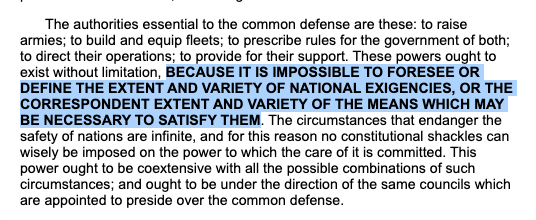Presidential Powers When All 50 States Have Declared a State of Emergency

All 50 States have declared a State of Emergency, so, under the Constitution & the National Emergencies Act, the President has temporary total authority for anything crisis related.
Federalist #23 Hamilton – https://avalon.law.yale.edu/18th_century/fed23.asp
6 OMG things a President can do with full National Emergency SIGNED BY ALL THE STATES
https://www.wearethemighty.com/presidents-emergency-powers?rebelltitem=1#rebelltitem1
We know our government as one of checks and balances, always ensuring that one branch has oversight over another. But in case of some kind of national emergency, the President of the United States has the ability to essentially turn the democratically-elected government into a sort of constitutional dictatorship, with him (or her) at its center.
This doesn’t mean the chief executive has to enact all the powers at once or that, in an emergency, that they have to enact them at all. These are just the possibilities. In case you read this and think to yourself, “Holy cow, no one is ever going to really do that!” Guess again. Most of these have been done before.
Precedents for the President
There are four aspects to an emergency: the sudden onset and how long it will last, how dangerous or destructive it is, who it may be dangerous to, and who is best suited to respond. The President has to declare a state of emergency and indicate which powers he’s activating.
1. Regulate all commerce and business transactions.
Under the Trading with the Enemy Act of 1917, the President is allowed to regulate all the finances of the United States, including all international transactions.
2. Seize all privately-held gold stores.
Under the same 1917 act of Congress, the President has the authority to take all privately-owned gold coin, gold bullion, and gold certificates. The last time this was used was in 1933 to mitigate the effects of the Great Depression. Citizens were allowed to keep only $100 worth of gold.
Citizens were paid its value per ounce and for the cost of transportation as they were required to surrender the gold to a Federal Reserve Bank within three days of the order.
3. Take control of all media in the U.S.
Under the Communications Act of 1934, the President can establish the Office of Telecommunications Management, which oversees all media and telecommunications, regardless of advances in technology. President Kennedy did this through Executive Order 10995 in 1962.
4. Basically capture all resources and manpower.
Kennedy also signed executive orders allowing for the seizure of electric power fuels and minerals, roads, highways, ports, sea lanes, waterways, railroads, and the private vehicles on those throughways. Under further orders, he allowed for the Executive Office of the President to conscript citizens as laborers, seize health and education facilities, and airports and aircraft. These are continued in Executive Orders 10997, 10999, 11000, 11001, 11002, 11003, 11004, and 11005.
5. Deploy the military inside the United States.
While American governors can offer their National Guard resources to the President without being ordered, as they do in the case of U.S. troops monitoring the border with Mexico, the use of Active Duty troops inside the U.S. is forbidden under the Posse Comitatus Act of 1878…
…unless there’s an emergency. The Insurrection Act allows for the President to use troops to put down insurrections or rebellions within the United States. After Hurricane Katrina, however, the Insurrection Act was amended to allow the POTUS to use federal troops to enforce the law — a violation of the Posse Comitatus Act. Every U.S. Governor was against this change.
6. Suspend the government of the United States.
A presidential directive signed by George W. Bush on May 9, 2007, gives the President of the United States the authority to take over all government functions and all private sector activities in the event of a “catastrophic emergency.” The idea is to ensure American democracy survives after such an event occurs and that we will come out the other end with an “enduring constitutional government.” This piece of legislation is called “Directive 51.”
Continuity of Government – 2020 – https://whitehouse.gov1.info/continuity-plan/
Buried deep within the 102-page National Continuity Plan is the strategy for the mass evacuation and relocation of every federal government agency including The White House and the military in response to an exceptional catastrophic event within the National Capital Region. Each agency is required to have a detailed Continuity of Operations Plan (COOP) in place.
Activation of the Shadow Government – President Bush activated the shadow government on September 11, 2001 shortly after the second attack on the World Trade Center. Shadow Government and Continuity of Government Link.
More Links:
- National Emergency Powers ›
- Emergency presidential power: From the drafting of the Constitution … ›
- Justice Department: President can’t use emergency powers in secret ›
- Emergency Power – Definition, Examples, Cases, Processes ›
- Emergency Powers | Wex Legal Dictionary / Encyclopedia | LII … ›
- Presidential Powers – LawShelf Educational Media ›
- Presidential Power: Crash Course Government and Politics #11 … ›
- Powers of the President of the United States – Wikipedia ›